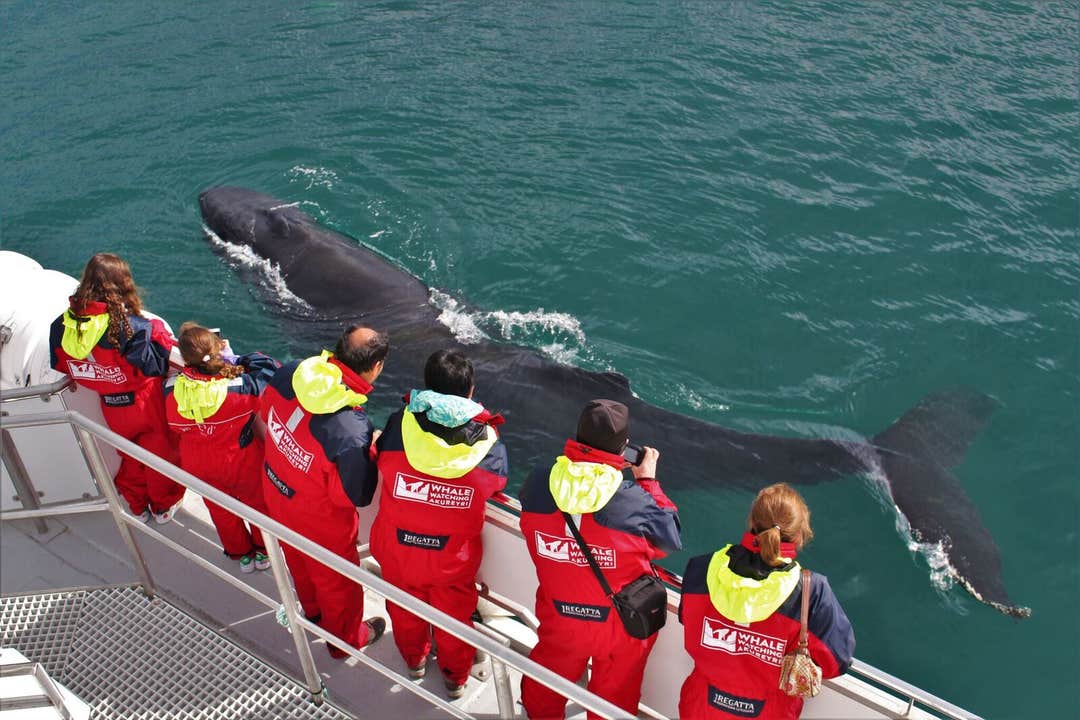소개
요약
소개
‘아이슬란드 북부의 수도’라 불리는 아쿠레이리(Akureyri)에서 고래 관측 투어를 떠나보세요! 에이야피요르두르(Eyjafjörður, 섬 피요르드 라는 뜻) 주변 바다에 서식하는 다양한 바다 생물들을 직접 만나볼 수 있는 멋진 기회입니다. 아이슬란드 북부를 여행 중에 대자연 속에서 야생 동물의 모습을 보고 싶은 분이라면 꼭 놓치지 말고 예약해보세요!
아쿠레이리 연안 바다 위에 떠 있는 선창에서 배를 타고 떠나는 투어로, 숙소까지 바로 도착하는 서비스를 이용할 수도 있지만 부두가 마을 가까이에 있어 편안하게 걸을 수 있는 거리입니다. 이 곳에서 고래 관측용 쾌속정을 타고 멋진 여행을 떠나 볼까요? 내부에는 편안한 실내 휴식 장소, 외부에는 고래 관측을 위한 관람대, 음료를 마실 수 있는 바와 추울 때 빌릴 수 있는 오버올 보관실까지 다양한 설비를 갖춘 선박이 기다리고 있습니다.
출발 시간이 되면 바다 속 거대한 친구들을 찾아 피요르드 쪽으로 배를 몰고 떠납니다. 아쿠레이리의 아름다운 풍경이 뒤편으로 멀어지는 가운데, 트롤라스카기(Tröllaskagi, 트롤 반도라는 이름) 위로 우뚝 선 멋진 산봉우리들이 점차 가까워질 거예요. 투어의 시작부터 멋진 풍경들이 펼쳐집니다. 이제 계속해서 배를 몰고 나가 고래들이 자주 출몰하는 서식지까지 다가갑니다.
아이슬란드 북부에서 가장 자주 목격되는 고래 종류는 혹등고래로, 겨울철에도 보이지만 특히 여름철에는 한층 더 자주 목격됩니다. 넘실거리는 파도 위로 곡예 하듯 유영하는 혹등고래는 인간에게 사교적인 성격이며 바다의 곡예사로 불릴 정도로 다양한 모습들을 선사합니다. 빠르게 헤엄쳐 가거나, 꼬리만 보여준 채 바다 깊이 들어가거나, 먹이를 먹는 등 대자연에서만 볼 수 있는 고래의 자연스럽고 멋진 모습을 감상해보세요!
연중 내내 흰부리돌고래, 쥐돌고래와 물개 또한 연안 바다에서 자주 만나볼 수 있습니다. 그 외에 피요르드 인근에서 목격된 것으로 알려진 종류로는 흰긴수염고래, 범고래, 참고래 등이 있으며, 연중 내내 이 지역에서 서식하는 건 아니지만 가끔 진귀한 장면을 연출하곤 하니 두 눈 크게 뜨고 바다를 살펴보세요!
여름철에 이 투어를 이용한다면 여름철에 아이슬란드를 번식지로 삼아 머무는 퍼핀의 모습도 볼 수 있을 거예요. 여름철에는 다른 바닷새 종류들만큼 많은 수의 퍼핀을 만날 수 있습니다. 비록 퍼핀은 겨울철에 아이슬란드를 떠나지만 그 외 다른 바닷새들은 여전히 머무르니 다른 새들의 모습도 감상해보세요. 주변 환경은 어느 계절이든 아주 아름답고, 특히 겨울철 눈에 덮인 풍경은 너무나 아름다와 할 말을 잊게 만들 정도예요.
약 세시간 동안 편안하게 개조된 쌍동선을 타고 아이슬란드에서 가장 긴 빙하 피요르드 주변을 항해할 예정입니다. 고래나 돌고래 등을 한 마리도 보지 못하는 경우는 매우 드문 경우이고, 지난 몇 년 동안 여름에는 100% 고래들의 멋진 모습을 감상할 수 있었습니다만 고래를 한 마리도 보지 못할 경우, 무료로 투어를 한번 더 즐길 수 있도록 기회를 드립니다.
더불어 기상 악화로 인해 투어가 취소될 경우, 일정에 맞는 때에 투어를 한번 더 참여하실 수 있습니다.
아이슬란드 북부 연안 바다에 서식하는 고래들을 직접 만나보세요! 평생 잊지 못할 추억을 만들어 드릴 거예요. 예약 희망 일자를 선택해서 예약 가능 여부를 확인해주세요!













